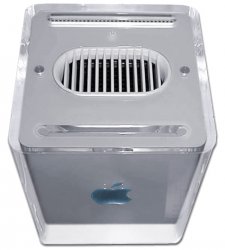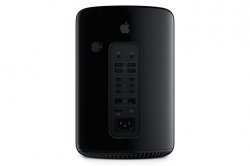But the extra PCIe slots in the current form factor are also woefully inadequate for GPUs so the "limited" 20Gbps performance of TB2 is not a good reason to prefer the current form factor. The six TB2 ports in the new machine are really competing with those two x4 PCIe slots in the current Mac Pro. It's hard not to argue you come out ahead with the new MP in this regard.
While the total throughput of ALL the TB2 slots on the new Mac Pro is higher than that of the current motherboard (not saying much, as it's a generation or two behind), it is NOT true that TB2 is any faster than the DUAL 16x PCIe 2.0 slots on the current mac pro, which clock in at about 8GBps each -- Thunderbolt 2 is 1/4 the speed. The remaining 2 PCIe 2.0 4x slots are roughly equal in speed. And again, this assumes thunderbolt 2 wont have any latency issues or other bottlenecks (as it has not been benchmarked publicly, it's hard to say).
http://support.apple.com/kb/ht2838
The Mac Pro (Early 2009), Mac Pro (Mid 2010), and Mac Pro (Mid 2012) computers implement PCI Express revision 2.0 for all four slots. Slots 1 and 2 are x16 slots, and slots 3 and 4 are x4 slots.
http://en.wikipedia.org/wiki/PCI_Express
So, a 16-lane slot (each direction):
v1.x: 4 GB/s (40 GT/s)
v2.x: 8 GB/s (80 GT/s)
v3.0: 15.75 GB/s (128 GT/s)
v4.0: 31.51 GB/s (256 GT/s)
v1.x: 4 GB/s (40 GT/s)
v2.x: 8 GB/s (80 GT/s)
v3.0: 15.75 GB/s (128 GT/s)
v4.0: 31.51 GB/s (256 GT/s)
EDIT: Woops, I see what you're saying: Since the new MP has all the GPU power you could ever want, the TB2 slots don't need to compete with the current 16x slots, they're competing with the remaining 4x slots.... Interesting point of view. Any reason why a motherboard produced today as opposed to 3 years ago couldn't make that upgrade? Perhaps Intel could just release a motherboard with PCIe and add TB2 slots? Maybe we could have a four PCIe 3.0 8x configuration? The limitations of the current Mac Pro have more to do with the fact that it's 3 (4?) years old, NOT that there's something inherently wrong with PCIe slots.
Edit2: ASUS just released a consumer board for less than $300, available today (not 6 months[ish] from now), which has THREE PCIe 16x 3.0 slots with a whopping 15.75GBps each -- nearly 8 times the bandwidth of thunderbolt 2, and there's Three of them. Oh, plus it has Three PCIe 3.0 1x slots, each has the bandwidth equal to Thunderbolt 1... and surround sound, because that was so much to ask
Last edited:



